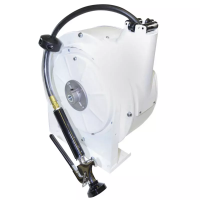Type 2500
20
Note
Any change in the PROPORTIONAL
BAND adjustment in the following step
changes the zero as well as the differen-
tial gap.
11. If the flexure strip base has been moved as far as
possible and the differential gap is still too large or too
small, adjust the PROPORTIONAL BAND as follows:
If the differential gap is too large, slightly de-
crease the PROPORTIONAL BAND setting.
If the differential gap is too small, slightly in-
crease the PROPORTIONAL BAND setting.
12. Repeat the procedure from step 4 until the re-
quired calibration points are obtained.
Note
If you cannot calibrate the controller,
look for other problems as described in
the Troubleshooting procedures, such
as a nozzle that is not perpendicular to
the flapper, leaky connections, or a
binding displacer rod. If none of these
troubles are apparent, ensure the dis-
placer is sized correctly for the applica-
tion.
Startup
Adjustment locations are shown in figure 12. The pre-
startup or calibration procedures must be completed
prior to startup.
Type 2500 Controller
1. Slowly open the upstream and downstream manual
control valves in the pipeline. If the pipeline has a by-
pass valve, close the valve.
2. If desired, adjust the proportional band to the nar-
rowest (lowest) setting that maintains stable control.
Proportional band adjustments will affect the process
level and may require a level adjustment. If adjusting
proportional band, make the adjustments in small in-
crements.
3. To confirm the optimum proportional band setting,
momentarily create a load upset. If cycling occurs,
broaden (increase) the proportional band until process
oscillations diminish rapidly. In general, the narrowest
proportional band that does not produce cycling pro-
vides the best control.
Type 2500T Transmitter
1. Make sure that the SPECIFIC GRAVITY and
ZERO ADJUSTMENT controls are set according to
the Type 2500 Controller or 2500T Transmitter portion
of the pre-startup checks procedures.
2. Slowly open the upstream and downstream manual
control valves in the pipeline. If the pipeline has a
manual bypass valve, close the valve.
Type 2500S Controller
1. Set the switching points according to the Type
2500S Controller portion of the prestartup checks pro-
cedures.
2. Slowly open the upstream and downstream manual
control valves in the pipeline. If the pipeline has a
manual bypass valve, close the valve.
3. If necessary, the proportional band may be ad-
justed to increase or decrease the differential gap. Ad-
just the RAISE LEVEL adjustment to reposition the
differential gap. After readjustment, confirm the con-
troller is still switching correctly at both switching
points.
Type 2503 Controller
1. Set the switching points according to the Type
2503 Controller portion of the prestartup checks proce-
dures.
2. Slowly open the upstream and downstream manual
control valves in the pipeline. If the pipeline has a
manual bypass valve, close the valve.
3. If necessary, reposition the switching points by ad-
justing the RAISE LEVEL control. For example, if the
differential gap is set for 4-inches (102 mm) of level
change, this 4-inches (102 mm) can be set anywhere
within the length of the displacer. After readjustment,
confirm the controller is still switching correctly at both
switching points.
Principle of Operation
The controller/transmitter receives the change in fluid
level, fluid-to-fluid interface level, or density from the
change in the buoyant force the fluid exerts on the
sensor displacer. The displacer, through a mechanical
linkage, imparts a rotary motion to the torque tube
shaft. This rotary motion positions the flapper accord-
ing to the level position of the displacer; the nozzle/
Bourdon tube arrangement sends a pneumatic signal
to the relay valve.
All 2500 and 2503 Series controller/transmitters use
the same basic pressure-balanced relay assembly.

